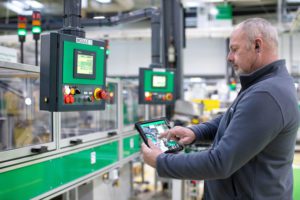Trends like the Industrial Internet of Things (IIoT) and new digital business models like “Everything as a Service” (XaaS) and “servitization” are driving major changes across industrial environments. Further technology breakthroughs (e.g., IT/OT integration, cloud computing, universal automation, and artificial intelligence) are helping manufacturers worldwide take more innovative approaches to building a digital business, enriching and simplifying processing tasks, and solving traditional bottlenecks.
Digital technology evolutions generate opportunities for enhanced operational agility and resilience, helping Industries of the Future navigate the risks and uncertainties of marketplace supply and demand fluctuations, climate, and social change, adapting / upskilling human capital to a digital world, and cybersecurity.
Process OEMs are key to this progression toward future industries. They possess a deep understanding of production operations across different industrial markets such as life science, metals, minerals and mining, food and beverage, water and wastewater, and chemical production industries. Their ability to integrate and link upstream and downstream industrial processes offer high business value to industrial manufacturers.
Process OEMs who provide digital services enable the transition acceleration of next-generation industries. This integration of services, or “servitization,” creates a new ability for process OMEs to simplify end-user manufacturing processes while optimizing performance.
Collaboration between technology suppliers and process OEMs drives digital business
Servitization is made possible by the software and product innovations of industrial automation solution vendors and the industry knowledge of process OEMs who deeply understand the relationships between core industrial technologies and the processes they support.
Software-based service solutions help address end-user process challenges and drive the rapid growth of services revenues for process OEMs.
For example, superior data access, consolidation, and analysis are now possible in food and beverage operations, along with decision support and benchmarking of Clean-In-Place (CIP) machines across multiple sites. This improves end-to-end traceability by accelerating contamination prevention, reducing production delays, simplifying regulatory compliance, and reducing CO2 emissions.
Process OEMs benefit from tools, like Schneider Electric’s EcoStruxure Clean-In-Place Advisor, that monitor operations to enable them to act as a remote expert to multiple end users, advising them on the best way to optimize the performance of their CIP processes. Consider the example of Nestlé Waters, where digital CIP systems helped to shorten cleaning times by 20% while emitting 50% fewer carbon emissions.
Another example of where digital tools can drive servitization revenues for process OEMs is in the domain of asset maintenance. Algorithms based on big data are moving the concept of predictive maintenance forward by enabling accurate predictions of future equipment failures.
In addition, step-by-step maintenance procedures now available as graphic images on handheld tablet devices are being adopted across different industrial segments, from water to steel and chemicals. Such tools not only onboard new employees faster but also make the execution of maintenance tasks safer.
Digital solutions, such as EcoStruxure Augmented Operator Advisor, allow non-experts at the site to be guided by process OEM remote experts to process quick, easy, and cost-effective machine fixes. Those fixes are triggered by sensors and software algorithms that capture the internal data related to the machine’s performance. Alerts are issued before unanticipated downtime occurs, strengthening operations’ overall resilience.
Plant and operations managers are responsive to these service offerings, enabling them to minimize traditional up-front CapEx spending in favor of longer-term OpEx spending. Process OEMs are particularly interested in implementing such digital tools because they help in:
- Expediting the delivery of more sustainable automation solutions
- Deepening relationships with end users throughout the machine’s lifecycle
- Providing insightful analytics for decision-making to end users, instead of just an equipment
- Expanding their ability to support end-user digital environments
- Generating new revenue streams for their organizations
Open, hardware-agnostic solutions accelerate the servitization trend
Some of the new digital tools also enable evolution to universal automation: the game-changer that promotes software-centric and asset-centric automation wraps and reuses existing systems and “plug and produce” portable and interoperable solutions. Universal automation optimizes IT/OT convergence and sets the stage for self-configuring, self-healing, fast retooling systems that drive speed and agility.
This openness is critical to driving the capability of plant owners to remain flexible and resilient in the new era of turbulent markets. The EcoStruxure Automation Expert software-centric industrial automation system offers an example of how universal automation can benefit both process OEMs and the end users they serve. The solution decouples software from dependence upon any specific hardware. It utilizes software-defined, brand-agnostic distributed controllers (virtual PLCs) within Linux-based industrial PCs to deliver advanced online services, remote support of field-based machines, and predictive analysis of internal machine performance.
Across key industries, process OEMs can leverage tools such as Ecostruxure Maintenance Advisor for earlier insight into abnormal asset conditions allowing maintenance staff to act before a failure occurs, and Ecostruxure Geo SCADA Expert, which is an open, flexible, and scalable software system for telemetry and remote SCADA solutions. These solutions transform field data into business-relevant information and optimize the operation and management of remote assets across critical infrastructures. By enhancing scalability and reliability, these tools help reduce the total cost of ownership.
To learn more about how servitization is transforming key process manufacturing industries, watch our webinar How servitization unlocks new revenue streams for process OEMs.
You might also be interested in what ARC Advisory Group recommends to industrial automation suppliers to boost their engineering productivity. You can download the report here.



